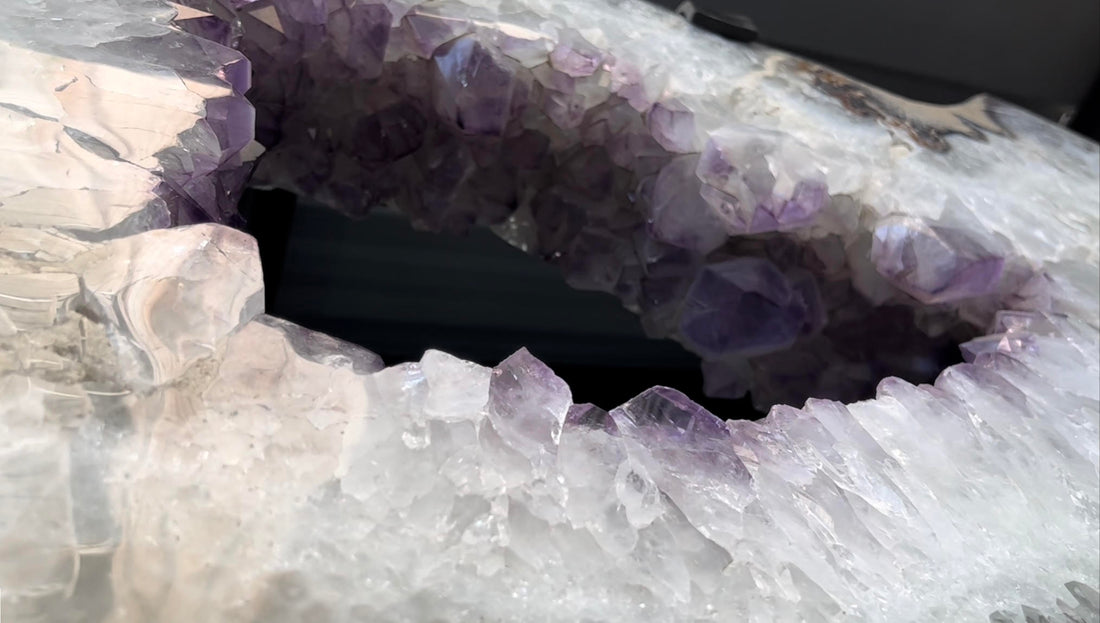Amethyst geodes, with their breathtaking beauty and hidden treasures, are captivating geological formations that hold unique and fascinating characteristics. While many people are familiar with their stunning appearance, there are lesser-known facts about amethyst geodes that add to their allure. Let's explore these intriguing aspects and unveil the secrets within these remarkable natural wonders.
-
Formation Process: Amethyst geodes are formed through a combination of volcanic activity and geological processes over millions of years. They begin as cavities or bubbles within volcanic rocks or lava flows. As these cavities cool and harden, mineral-rich fluids seep into the hollow spaces and slowly deposit layers of quartz crystals, including the beautiful purple amethyst variety.
-
Crystal Growth and Structure: The inside of an amethyst geode is lined with stunning crystal formations. The growth of these crystals is a slow and gradual process that occurs over thousands of years. Amethyst crystals typically form in a hexagonal prism shape with a pointed tip known as a termination. The crystals grow inward from the walls of the geode, gradually filling the cavity with their intricate and mesmerizing structures.
-
Geode Sizes and Variations: Amethyst geodes can vary greatly in size, ranging from small ones that fit in the palm of your hand to massive formations that stand several feet tall. The size and quality of the crystals within a geode can also vary, creating a unique and individualized display of color and patterns. Some geodes may contain large, fully formed amethyst crystals, while others may have smaller crystals densely packed together.
-
Color Intensity and Geographical Influence: The color intensity of amethyst crystals within geodes can vary depending on their geographical origin. Brazilian amethyst geodes, for example, often exhibit deep and vibrant purple hues, while Uruguayan geodes may feature a darker shade with hints of violet. Factors such as iron impurities and the specific mineral composition of the surrounding rock can influence the color intensity and variations within the geode.
-
Hidden Treasures Within: Apart from the stunning amethyst crystals, geodes can also contain other fascinating mineral inclusions and formations. These can include minerals such as calcite, agate, quartz druse, and various other colorful crystalline formations. Each geode holds a unique combination of minerals, making the exploration and discovery of these hidden treasures a true delight for collectors and enthusiasts.
-
Geological Time Capsules: Amethyst geodes serve as remarkable geological time capsules, offering a glimpse into the Earth's ancient history. The slow formation process, spanning millions of years, captures a moment frozen in time. The crystals within a geode can reveal valuable insights into the geological processes, mineral deposition, and environmental conditions that existed during their formation.
-
Metaphysical Properties: Like individual amethyst crystals, amethyst geodes are believed to possess metaphysical properties. They are associated with spiritual growth, intuition, and inner peace. Amethyst geodes are often used in meditation practices, as their calming and harmonizing energies create a serene and sacred space for self-reflection and spiritual connection.
Amethyst geodes are natural marvels that showcase the incredible beauty and geological processes of the Earth. With their stunning crystals, varied colors, and hidden treasures, they offer a glimpse into the intricate wonders of nature. Whether admired for their aesthetic appeal, appreciated as geological artifacts, or cherished for their metaphysical properties, amethyst geodes continue to fascinate and inspire awe in those who encounter them.

